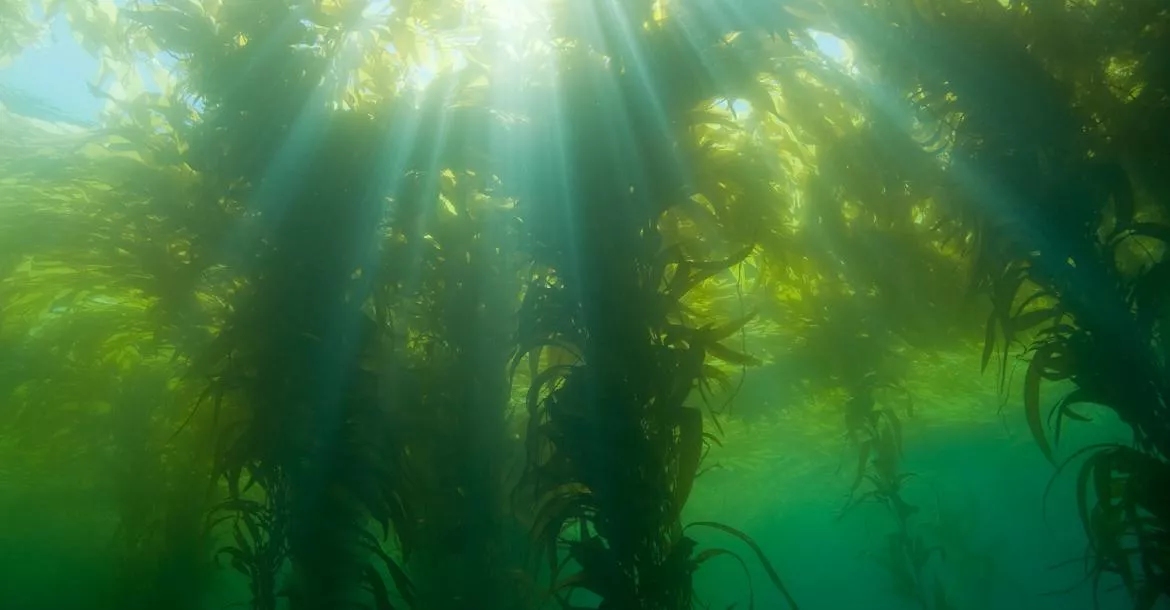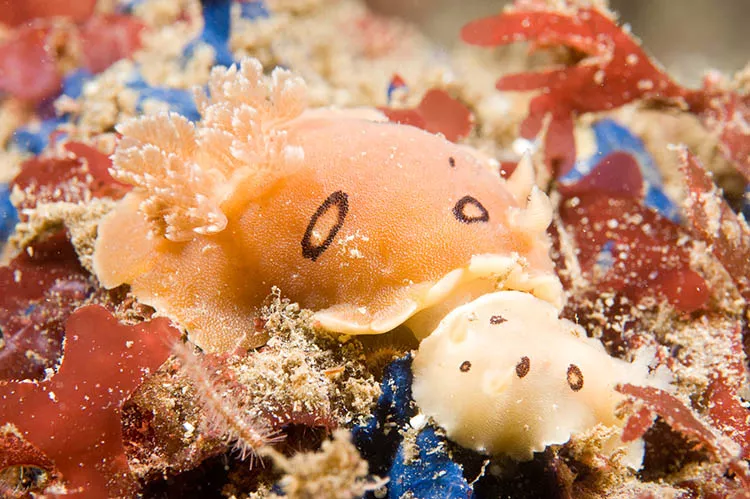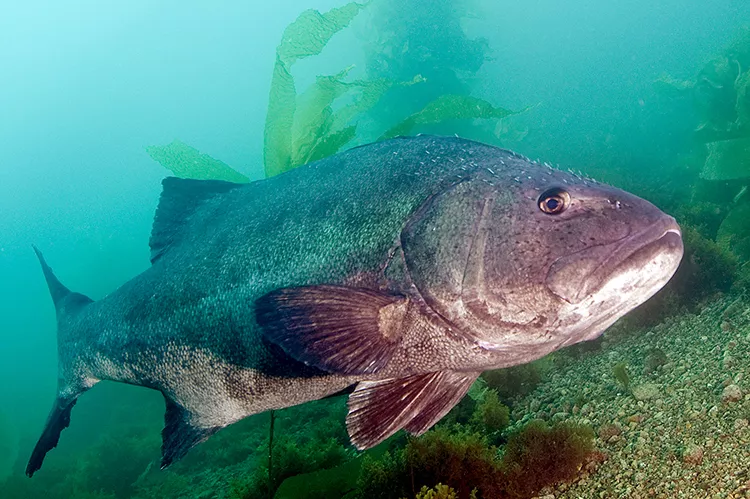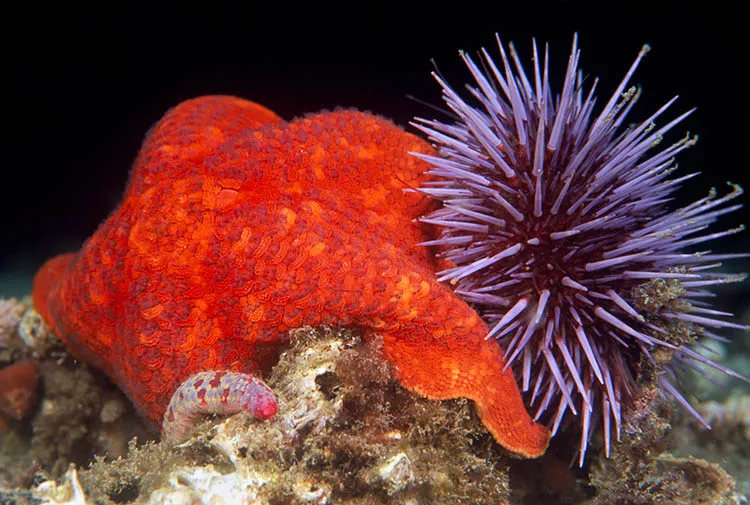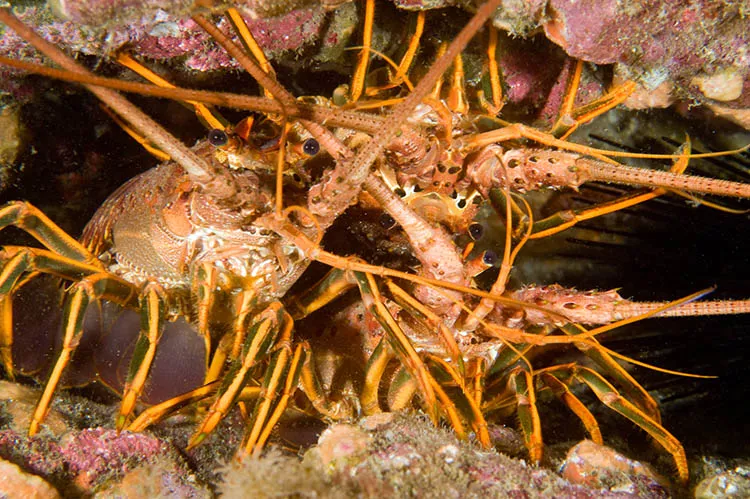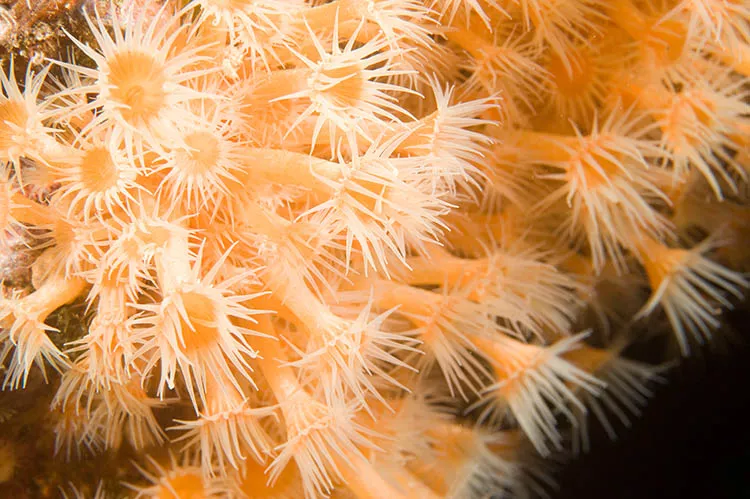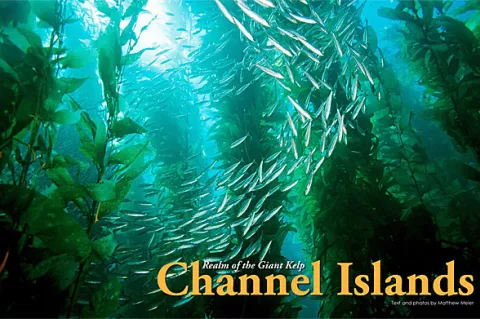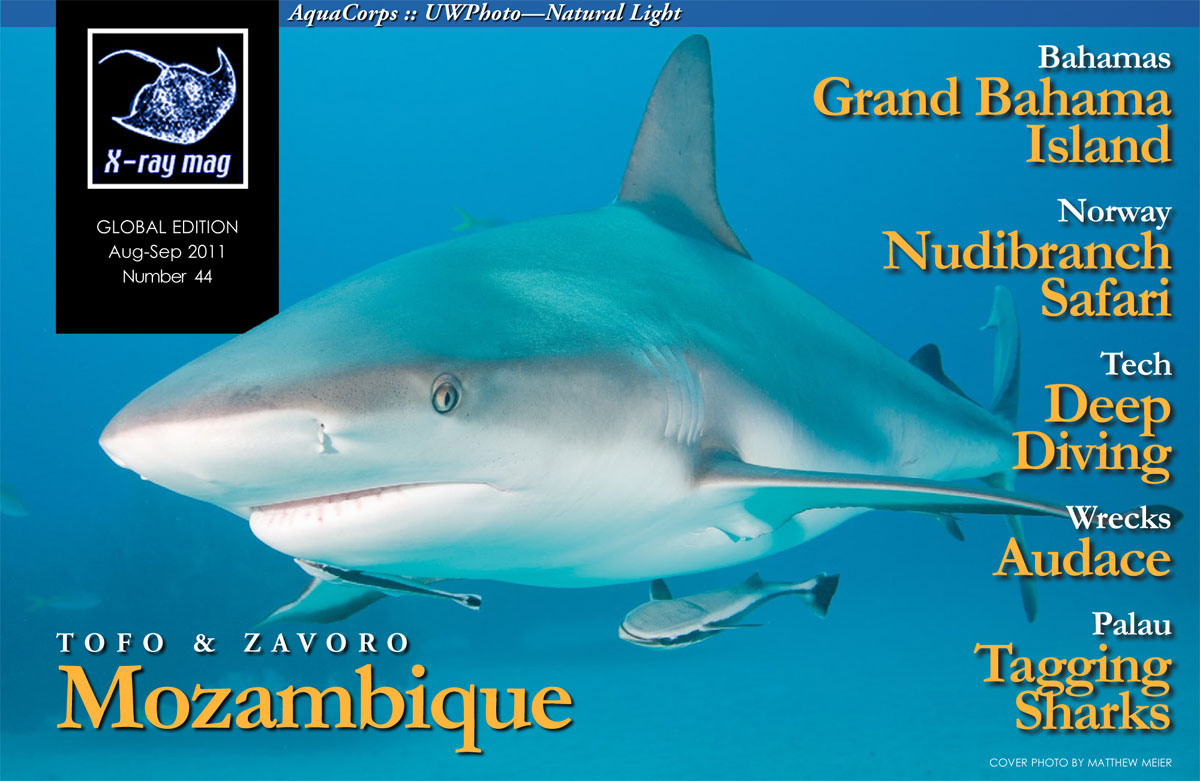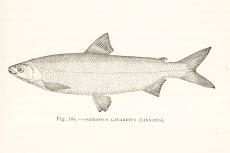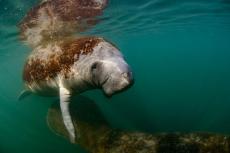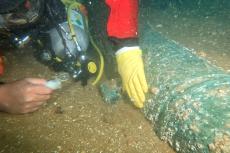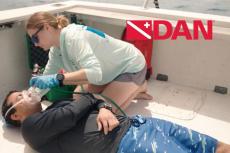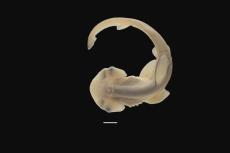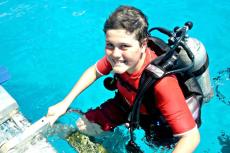For those of us fortunate enough to call Southern California home, the Channel Islands offer world-class diving in our own backyard. Comprised of eight islands stretching over 160 miles of Pacific Ocean, the Channel Islands boast over 2,000 terrestrial plants and animals, including 150 endemic species, rivaling the Galapagos for diversity.
Contributed by
My first underwater photos were taken at the Channel Islands, and I have returned every year since. On my most recent trip, the liveaboard spent two days anchored at one dive site, in which time, none of the 20 photographers and videographers onboard ran out of subjects to shoot. We were privileged to have harbor seals and California sea lions nearby, a vertical wall of rocky reef full of macro subjects, bat rays in the sand below the boat, and schools of Jack mackerel, opaleye and blacksmith fish, along with soupfin and leopard sharks swimming in the shallow waters of the giant kelp forest.
On one particular night dive, I discovered an elusive two-spot octopus moving across my fin, as I knelt in the sand. Octopuses are not often seen during the day, preferring to stay in their den or else hidden in plain sight, camouflaged against the rocky reef. With no room to get down on its level, I was left to hold my camera just above the sand, shooting blindly as it moved away. Days later, when my film was developed, I was rewarded with one of my more unforgettable octopus images.
Big fish
Spectacular to see underwater, giant sea bass are the largest species of fish living in the kelp forest. They can grow to be over seven feet in length and weigh upwards of 700 pounds. Due to their dwindling numbers from overfishing, giant sea bass have been protected in California waters since 1982. While still listed as a critically endangered species, giant sea bass are slowly making a come-back. Swimming alongside one of these behemoths is truly an amazing experience.
The Channel Islands support numerous shark and ray species. I have had good luck photographing soupfin and leopard sharks at San Clemente Island, horn sharks at Catalina and bat rays at most islands. It is also possible to see blue sharks, mako sharks, angel sharks, swell sharks, stingrays, shovelnose guitarfish and electric rays to name a few. In the ’60s and ’70s, basking sharks were common in the Santa Barbara Channel, but by now they have all but disappeared.
No visit to the Channel Islands is complete without encountering the charismatic and vibrant garibaldi, California’s official state saltwater marine fish. They are found only in the Eastern Pacific Ocean from Monterey Bay down to Baja and are abundant at the Channel Islands. Garibaldi are the largest member of the damselfish family, growing up to 12 inches in length and are a striking orange in color.
A juvenile Garibaldi’s color is slightly less vibrant, and it has luminous blue spots that disappear by the time it reaches adulthood. In summer, male Garibaldi construct circular nests on flat sections of rocky reef and then guard their nests after the female deposits her eggs. They are incredibly territorial during this time period and will attack much larger fish and even humans to protect their developing young.
Diving
Scuba diving at the Channel Islands is almost exclusively achieved by means of a day or multi-day boat trip from the mainland. Dive boats run out of harbors like Santa Barbara, Ventura, Los Angeles, Long Beach, San Pedro, Dana Point and San Diego. Single-day trips usually allow for three to four dives, before returning back to the docks in late afternoon. Transport times differ depending on the harbor, boat and destination, but most range between one to two hours. The charters vary from intimate, six passenger vessels to 30+ passenger liveaboard boats.
Diving in California is for the hardy and self-reliant. The water is cold, the gear extensive and the pampering virtually nonexistent. On most boats, divers are required to provide their own equipment, tanks and even weights and to transport that gear onboard themselves. Once in the water, divers are expected to be able to read their compass, manage their bottom time and find their way back to the boat. Dive masters typically do not conduct a follow-the-leader guided tour and may not even get wet. The reward for all this effort however, is magnificent diving and absolute freedom underwater. Plus, you finally get to prove you were paying attention during that navigation speciality course.
Visibility at the islands averages 30 feet and on a good day can reach 100+ feet. Water temperatures typically vary 5-10 degrees from the northern to southern islands. Average winter surface temperatures range from 53-59°F, while summer temperatures fluctuate between 62-70°F, though the water is typically cooler at depth. A drysuit or 7mm wetsuit, hood, boots and gloves are recommended.
The islands
Santa Catalina Island maintains the only permanent, non-military settlement on the islands, with the majority of residents living in either Avalon or Two Harbors. Boat ferries are the most common means of transportation to Catalina, though helicopter and plane rides are also available. Once on Catalina, there are a wide variety of quaint hotels and restaurants to choose from, the vast majority within walking distance of the ferry dock. Several dive boats operate out of Catalina and shore diving is also available. A must-see is the Casino Point Marine Park, which was established as a marine reserve in 1965 by the city of Avalon. This shore dive is easily accessible by concrete steps taking you straight into the water.
The four northern Channel Islands (Anacapa, Santa Cruz, Santa Rosa and San Miguel), along with Santa Barbara Island comprise the Channel Islands National Park (CINP). The National Park expanded the protections of the Channel Islands National Monument, created in 1938 by U.S. President Franklin Delano Roosevelt, which covered only the islands of Anacapa and Santa Barbara.
Surrounding the entire CINP is the Channel Islands National Marine Sanctuary (CINMS). The sanctuary is a marine protected area administered by NOAA (National Oceanic and Atmospheric Administration) that encompasses 1,250+ nautical square miles of the Pacific Ocean, from the high tide line of the CINP, to six nautical miles offshore. Both were established in 1980 and together they help to protect the natural and cultural resources on the islands.
Marine mammals
A wide variety of marine mammals call the islands home, and at various times of the year, many more pass through on their migratory routes. Nearly 30 species of cetaceans (dolphins and whales) have been observed, with 18 species listed as residents. Pacific gray whales migrate during the months of December through March, heading south from their Arctic feeding grounds towards the warmer waters of Baja California, Mexico, to give birth. In the summer months of July to September, humpback whales, fin whales and blue whales come to feed. This aggregation of blue whales is the largest of it’s kind, with nearly ten percent of the world’s population gathered in the Santa Barbara Channel.
Visitors will frequently see large pods of common dolphins and occasionally much smaller pods of Risso’s dolphins at the surface. Less frequently encountered are pacific white-sided and bottlenose dolphins. A few lucky visitors will experience dolphins or even a whale underwater while diving around the Channel Islands, but the vast majority of these sightings will be from the deck of a boat. Several tour boat operators run whale watching cruises, specifically to search out these majestic creatures.
A few years back I had the pleasure of watching a humpback whale in the Santa Barbara Channel while returning from a dive trip. The whale was leaping out of the water, in a behavior known as breaching, at seemingly regular intervals. As we waited for its next breach and tried to estimate where it might reappear, the whale advanced much closer than anticipated. I was able to snap four photos as it breached perhaps 20 yards from the boat and landed with a monstrous splash. Thanks to modern technology, my photos were actually in focus, though much more tightly cropped than I envisioned. To this day, that is one of my favorite wildlife viewing experiences.
There are four species of pinnipeds (seals and sea lions) at the islands, including the California sea lion, harbor seal, northern elephant seal and the northern fur seal. In years past, Guadalupe fur seals and stellar sea lions also visited the islands, but today, are rarely seen. On the northernmost island of San Miguel, hundreds of thousands of pinnipeds gather, breeding at different times of the year, to form one of the largest congregations of wildlife in the world.
The leeward side of Santa Barbara Island plays host to a rookery of California sea lions. Hundreds of sea lions haul out on the rocks at night to sleep or to laze about in the sun during the day. Pups are born in the spring and learn to swim under the watchful eye of adults in the calm, shallow waters close to shore. By mid-summer, they are graceful swimmers and curious to explore their world. This is a popular dive destination and well worth the trip. Some of my most memorable dives have been at Santa Barbara Island watching playful sea lions swim circles around me.
Topside adventures
The Channel Islands offer a wide range of activities for non-divers as well. Water-based activities include whale watching, kayaking, boating, fishing, surfing, tide pooling and snorkeling. Camping and hiking are allowed on all of the islands except San Clemente and San Nicolas, which are controlled by the U.S. Navy and off-limits to the public, though diving is permitted in the waters around those islands. Limited backcountry camping is allowed on Santa Cruz and Santa Rosa. Facilities differ, but most are primitive, so be sure to check on conditions and necessary equipment before you go. Hiking trails vary from maintained roads and paths with directional signage to rugged, unmarked, and mountainous. Day hikers need to plan their routes accordingly, to be certain they are back at the dock in time for their boat ride home. In late winter and spring, the islands are usually lush and alive with wildflowers in full bloom.
Bird watching at the islands can be spectacular. Over 60 species of seabirds winter, feed, nest or migrate through and 99 percent of all Southern California seabirds utilize the islands for nesting and feeding grounds. The islands also play host to the only nesting population of brown pelicans on the U.S. west coast. Once threatened by pesticides like DDT, the California inhabitants have made a remarkable comeback.
Divers and non-divers alike will appreciate the diversity and beauty of the Channel Islands. ■
Matthiew Meier is an underwater photographer and dive writer based in San Diego, California. For more information and to order prints, visit: www.matthewmeierphoto.com

